Study on Composite Fracture Characteristics and Hydraulic Fracturing Behavior of Hard Rock
Abstract
:1. Introduction
2. Composite Fracture Characteristics in the Fracture Toughness Test
2.1. The GMTS Criterion
- Cracks initiate at the crack tip radially in the direction of the maximum tangential stress σθ.
- Based on the tangential stress σθ achieving its maximum value σθmax, the angle of crack propagation θ0 is determined.
- A fracture occurs at a radial distance rc along the crack tip, simultaneously with the tangential stress σθ exceeding the tensile strength σt.
2.2. The Composite Stress Intensity Factor of the CSTBD Specimen
3. Composite Fracture Characteristics in Hard Rock
3.1. The CSTBD Splitting Test and Results
3.2. Verification of Fracture Criteria
4. Characteristics of Composite Hydraulic Fracturing in Hard Rock
4.1. Composite Stress Intensity Factors in Hydraulic Fractures
4.2. Calculation of Critical Rupture Pressure
4.3. Influence of T Stress on pb and θc
5. True Triaxial Hydraulic Fracturing Test Verification
5.1. Test Scheme

5.2. Test Results
5.3. Verification of pb
6. Conclusions
- (1)
- T stress affects the I–II fracture characteristics of hard rock. Based on the GMTS criterion considering T stress, the ratio of I–II composite stress intensity factor to the pure I-type fracture toughness of rock is derived, which can be used to predict I–II composite stress intensity factor of rock. By substituting the boundary conditions of CSTBD samples into GMTS criteria, it is found that GMTS criteria are more effective in predicting the I–II stress intensity factor of hard rock CSTBD samples.
- (2)
- In the hydraulic fracturing environment, the hydraulic fracture has an angle with the maximum horizontal principal stress, resulting in I–II composite fracture. At this time, the influence of T stress on the I–II fracture characteristics of hard rock is relatively small. In engineering practice, the pure I-type fracture toughness of hydraulic fracture is obtained, and the critical fracture pressure at different angles between hydraulic fracture and maximum horizontal principal stress can be predicted based on the traditional MTS criterion, which does not consider T stress.
Author Contributions
Funding
Data Availability Statement
Conflicts of Interest
References
- Janiszewski, M.; Shen, B.; Rinne, M. Simulation of the interactions between hydraulic and natural fractures using a fracture mechanics approach. J. Rock Mech. Geotech. Eng. 2019, 11, 1138–1150. [Google Scholar] [CrossRef]
- Yue, K.; Lee, H.P.; Olson, J.E.; Schultz, R.A. Apparent fracture toughness for LEFM applications in hydraulic fracture modeling. Eng. Fract. Mech. 2020, 230, 106984. [Google Scholar] [CrossRef]
- Zhang, Z.-T.; Wang, Y.-H.; Gao, W.-H.; Hu, W.; Liu, S.-K. Permanent Deformation and Its Unified Model of Coal Gangue Subgrade Filler under Traffic Cyclic Loading. Appl. Sci. 2023, 13, 4128. [Google Scholar] [CrossRef]
- Zhang, Z.-T.; Gao, W.-H.; Wang, X.; Zhang, J.Q.; Tang, X.-Y. Degradation-induced evolution of particle roundness and its effect on the shear behaviour of railway ballast. Transp. Geotech. 2020, 24, 100388. [Google Scholar] [CrossRef]
- Xiong, D.; Ma, X. Influence of natural fractures on hydraulic fracture propagation behavior. Eng. Fract. Mech. 2022, 276, 108932. [Google Scholar] [CrossRef]
- González-Velázquez, J.L. A Practical Approach to Fracture Mechanics; Elsevier: Amsterdam, The Netherlands, 2021; pp. 35–74. [Google Scholar] [CrossRef]
- Erdoga, F. On the Crack Extension in Plates under Plane Loading and Transverse Shear. J. Basic Eng. 1963, 85, 519–525. [Google Scholar] [CrossRef]
- Sih, G.C. Some basic problems in fracture mechanics and new concepts. Eng. Fract. Mech. 1973, 5, 365–377. [Google Scholar] [CrossRef]
- Nuismer, R.J. An energy release rate criterion for mixed mode fracture. Int. J. Fract. 1975, 11, 245–250. [Google Scholar] [CrossRef]
- Tang, S.B. The effect of T-stress on the fracture of brittle rock under compression. Int. J. Rock Mech. Min. Sci. 2015, 79, 86–98. [Google Scholar] [CrossRef]
- Mirsayar, M.M.; Razmi, A.; Aliha, M.R.M.; Berto, F. EMTSN criterion for evaluating mixed mode I/II crack propagation in rock materials. Eng. Fract. Mech. 2018, 190, 186–197. [Google Scholar] [CrossRef]
- Matvienko, Y.G. The Effect of the Non-singular T-stress Components on Crack Tip Plastic Zone under Mode I Loading. Procedia Mater. Sci. 2014, 3, 141–146. [Google Scholar] [CrossRef]
- Andrade, H.C.; Trevelyan, J.; Leonel, E.D. Direct evaluation of stress intensity factors and T-stress for bimaterial interface cracks using the extended isogeometric boundary element method. Theor. Appl. Fract. Mech. 2023, 127, 104091. [Google Scholar] [CrossRef]
- Esmaeili, A.; Mohammadi, B.; Yousefi, A. Investigation of T-stress and tensile strength effect on crack tip conditions and crack initiation angle in off-axis laminate composite. Theor. Appl. Fract. Mech. 2024, 130, 104283. [Google Scholar] [CrossRef]
- Tutluoglu, L.; Batan, C.K.; Aliha, M.R.M. Tensile mode fracture toughness experiments on andesite rock using disc and semi-disc bend geometries with varying loading spans. Theor. Appl. Fract. Mech. 2022, 199, 103325. [Google Scholar] [CrossRef]
- Williams, J.G.; Ewing, P.D. Fracture under complex stress—The angled crack problem. Int. J. Fract. 1972, 8, 441–446. [Google Scholar] [CrossRef]
- Smith, D.J.; Ayatollahi, M.R.; Pavier, M.J. The role of T-stress in brittle fracture for linear elastic materials under mixed-mode loading. Fatigue Fract. Eng. Mater. Struct. 2008, 24, 137–150. [Google Scholar] [CrossRef]
- Ayatollahi, M.R.; Moghaddam, M.; Berto, F. A generalized strain energy density criterion for mixed mode fracture analysis in brittle and quasi-brittle materials. Theor. Appl. Fract. Mech. 2015, 79, 70–76. [Google Scholar] [CrossRef]
- Ayatollahi, M.R.; Razavi, S.M.J.; Rashidi Moghaddam, M.; Berto, F. Mode I Fracture Analysis of Polymethylmetacrylate Using Modified Energy-Based Models. Phys. Mesomech. 2015, 18, 326–336. [Google Scholar] [CrossRef]
- Huang, X. Combined effects of in-plane and out-of-plane constraints on fracture behaviors in central-cracked stiffened plates: A model based on plastic zone size. Eng. Fract. Mech. 2021, 255, 107958. [Google Scholar] [CrossRef]
- Zhu, Q.; Li, D.; Ma, J.; Han, Z.; Li, X. Mixed mode I/II fracture behavior and surface morphology of hard rock under dynamic loading. Theor. Appl. Fract. Mech. 2023, 125, 103860. [Google Scholar] [CrossRef]
- Li, J.; Hua, W.; Tang, H.; Huang, J.; Dong, S. Stress intensity factors and T-stress for an edge cracked Brazilian disk specimen under diametrically distributed load. Theor. Appl. Fract. Mech. 2022, 120, 103402. [Google Scholar] [CrossRef]
- Shen, Z.; Yu, H.; Guo, L.; Hao, L.; Huang, K. A modified G criterion considering T-stress and differentiating the separation and shear failure in crack propagation. Int. J. Solids Struct. 2022, 236–237, 111357. [Google Scholar] [CrossRef]
- Tang, X.; Wan, W.; Chen, W.; Zhang, Z. Analysis of Fracture Characteristics of Ore Rock Based on GMTS Criterion. KSCE J. Civ. Eng. 2023, 27, 4352–4361. [Google Scholar] [CrossRef]
- Luo, Z.; Zhang, N.; Zhao, L.; Yao, L.; Liu, F. Seepage-stress coupling mechanism for intersections between hydraulic fractures and natural fractures. J. Pet. Sci. Eng. 2018, 171, 37–47. [Google Scholar] [CrossRef]
- Song, M.; Li, Q.; Hu, Q.; Wu, Y.; Ni, G.; Xu, Y.; Zhang, Y.; Hu, L.; Shi, J.; Liu, J.; et al. Resistivity response of coal under hydraulic fracturing with different injection rates: A laboratory study. Int. J. Min. Sci. Technol. 2022, 32, 807–819. [Google Scholar] [CrossRef]
- Suo, Y.; Dong, M.; Wang, Z.; Gao, J.; Fu, X.; Pan, Z.; Xie, K.; Qi, T.; Wang, G. Characteristics of mixed-mode I–II fracture of bedding mud shale based on discrete element method. J. Pet. Sci. Eng. 2022, 219, 111135. [Google Scholar] [CrossRef]
- Tada, H.; Paris, P.C.; Irwin, G.R. The Stress Analysis of Cracks; ASME Press: New York, NY, USA, 2000; p. 291. [Google Scholar]
- Papanastasiou, P. An efficient algorithm for propagating fluid-driven fractures. Comput. Mech. 1999, 24, 258–267. [Google Scholar] [CrossRef]
- Li, X.; Liang, Y.; Luo, Y.; Ai, C. Predicting hydraulic fracture propagation based on maximum energy release rate theory with consideration of T-stress. Fuel 2020, 269, 117337. [Google Scholar] [CrossRef]
- Rahman, M.K.; Hossain, M.M.; Rahman, S.S. An analytical method for mixed-mode propagation of pressurized fractures in remotely compressed rocks. Int. J. Fract. 2000, 103, 243–258. [Google Scholar] [CrossRef]
- Fan, Y.; Zhu, Z.; Zhao, Y.; Zhou, C.; Zhang, X. Theoretical research on formation fracture pressure and initiation Angle based on wellbore perforation model. J. Cent. South Univ. 2019, 50, 669–678. [Google Scholar] [CrossRef]
- Zhang, Z.T.; Gao, W.H. Effect of different test methods on the disintegration behaviour of soft rock and the evolution model of disintegration breakage under cyclic wetting and drying. Eng. Geol. 2020, 279, 105888. [Google Scholar] [CrossRef]
- Zhang, Z.T.; Gao, W.H.; Zeng, C.F.; Tang, X.Y.; Wu, J. Evolution of the disintegration breakage of red-bed soft rock using a logistic regression model. Transp. Geotech. 2020, 24, 100382. [Google Scholar] [CrossRef]
- Schultz, R.A. Growth of geologic fractures into large-strain populations: Review of nomenclature, subcritical crack growth, and some implications for rock engineering. Int. J. Rock Mech. Min. Sci. 2000, 37, 403–411. [Google Scholar] [CrossRef]
- Ke, C.C.; Chen, C.S.; Tu, C.H. Determination of Fracture Toughness of Anisotropic Rocks by Boundary Element Method. Rock Mech. Rock Eng. 2008, 41, 509–538. [Google Scholar] [CrossRef]
- Dong, W.; Yang, D.; Zhang, B.; Wu, Z. Rock-concrete interfacial crack propagation under mixed mode I–II fracture. J. Eng. Mech. 2018, 144, 04018039. [Google Scholar] [CrossRef]
- Zhao, Y.; Zhang, L.; Wang, Y.; Lin, H. Thermal-Hydraulic-Mechanical (THM) Coupling Behaviour of Fractured Rock Masses. Geofluids 2023, 2023, 9764934. [Google Scholar] [CrossRef]
- Ingraffea, A.R. 3—Theory of Crack Initiation and Propagation in Rock. In Fracture Mechanics of Rock; Academic Press: Cambridge, MA, USA, 1987; pp. 71–110. [Google Scholar] [CrossRef]
- Jin, P.; Liu, Z.; Wang, X.; Chen, X. Three-Dimensional analysis of mixed mode Compact-Tension-Shear (CTS) Specimens: Stress intensity Factors, T-stresses and crack initiation angles. Theor. Appl. Fract. Mech. 2022, 118, 103218. [Google Scholar] [CrossRef]
- Wang, C.; Wang, S. Modified generalized maximum tangential stress criterion for simulation of crack propagation and its application in discontinuous deformation analysis. Eng. Fract. Mech. 2022, 259, 108159. [Google Scholar] [CrossRef]
- Mroz, K.P. Fatigue Cracks Growth in the Bimaterial System, The Mathematical Model and Numerical Solution; IPPTPAN (IFTRPAS): Warsaw, Poland, 2008. (In Polish) [Google Scholar]
- Yin, T.; Wu, Y.; Wang, C.; Zhuang, D.; Wu, B. Mixed-mode I + II tensile fracture analysis of thermally treated granite using straight-through notch Brazilian disc specimens. Eng. Fract. Mech. 2020, 234, 107–111. [Google Scholar] [CrossRef]
- Zhou, Z.; Yang, H.; Wang, X.C.; Zhang, Q.F. Fractured rock mass hydraulic fracturing under hydrodynamic and hydrostatic pressure joint action. J. Cent. South Univ. 2016, 23, 2695–2704. [Google Scholar] [CrossRef]
- He, H.; Cheng, R.; Zhao, J.; Men, Z.; Mu, Z. Research on the initiation pressure criterion of directional hydraulic fracturing in coal mine. Heliyon 2023, 9, e17638. [Google Scholar] [CrossRef] [PubMed]
- Ye, H.; Yang, L.; Liu, Z.; Deng, Q. Study on acoustic emission response characteristics of sandstone in directional fracturing under different filtration surfaces. Saf. Coal Mine 2022, 53, 62–67. [Google Scholar] [CrossRef]
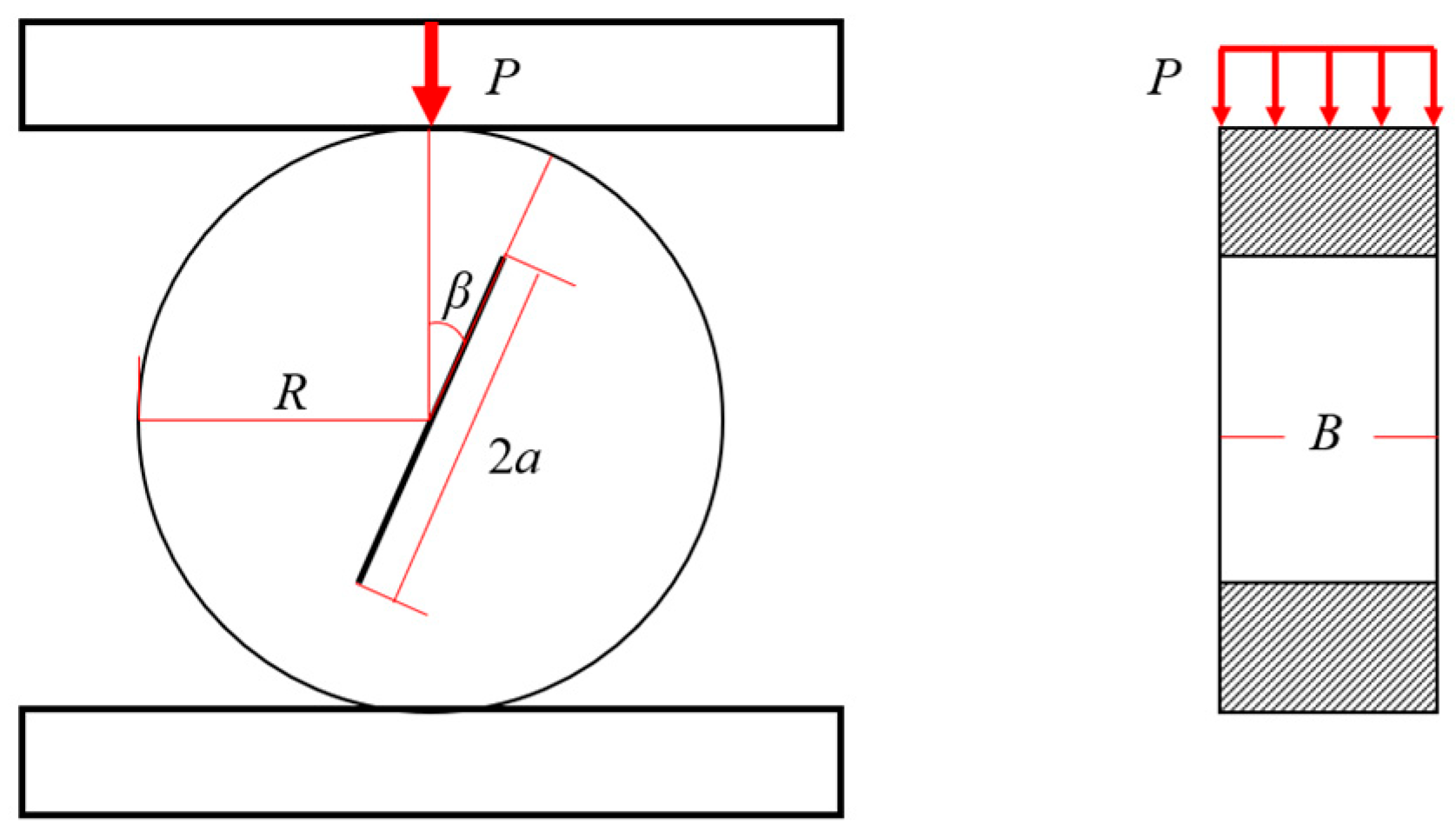


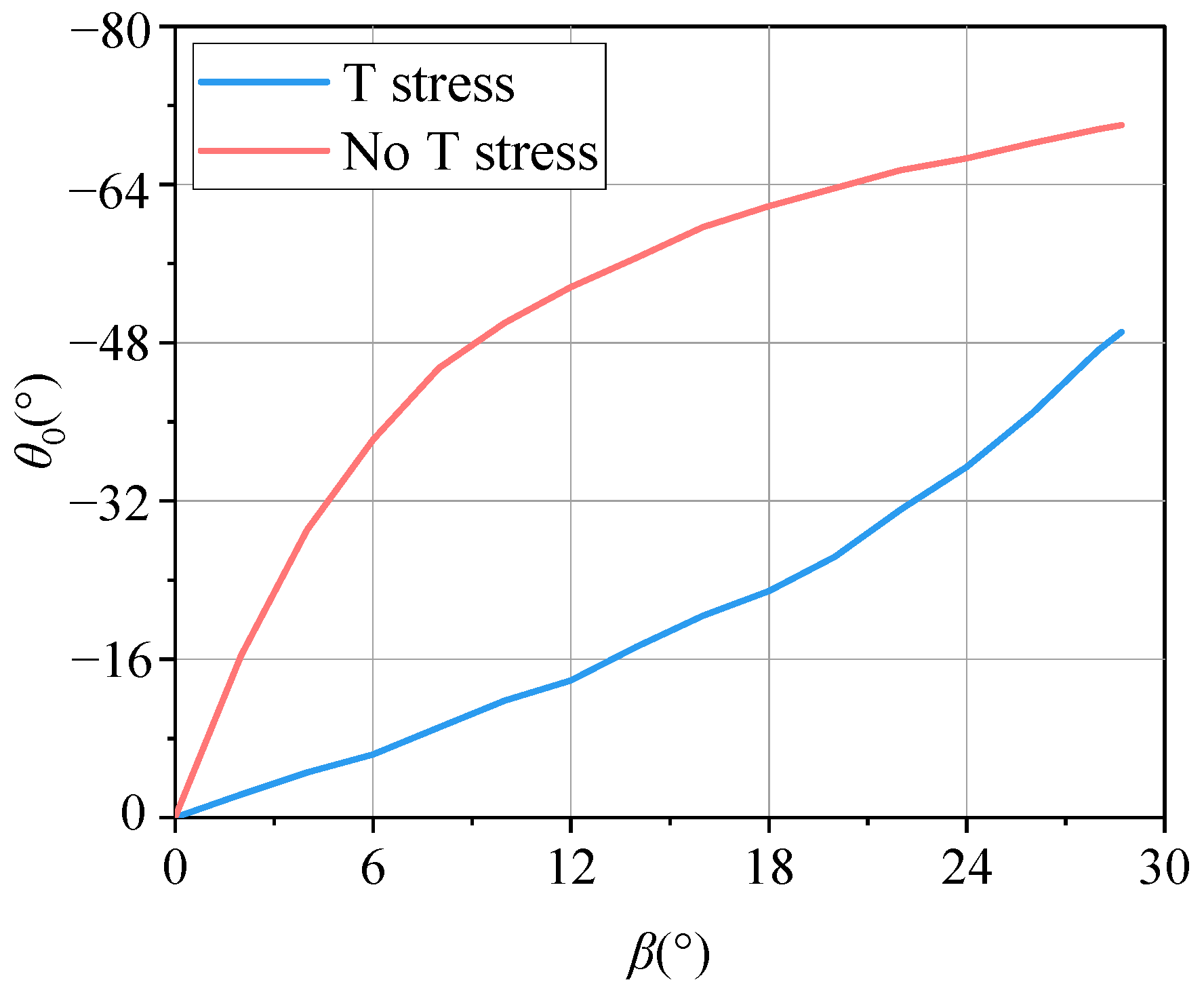
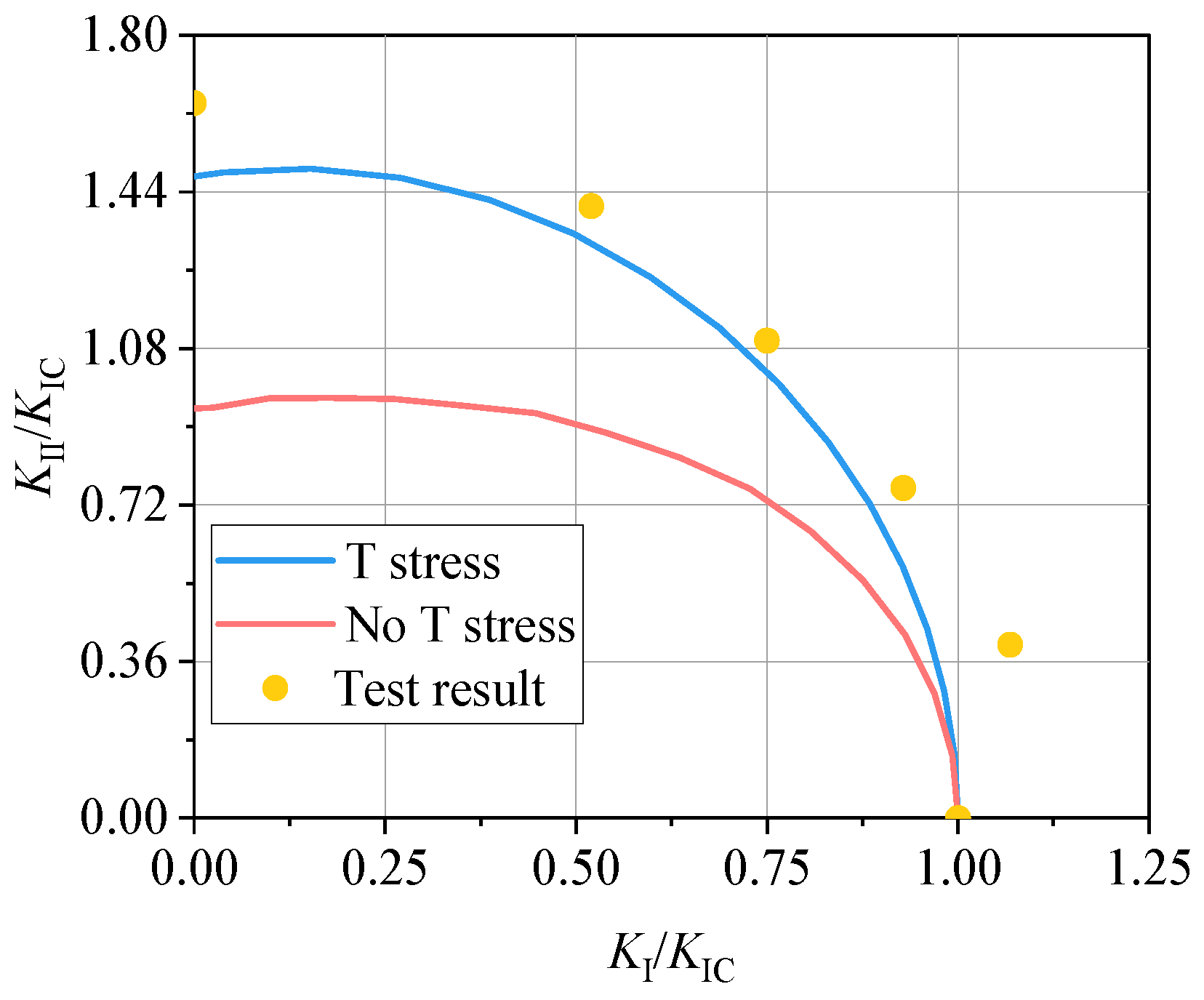


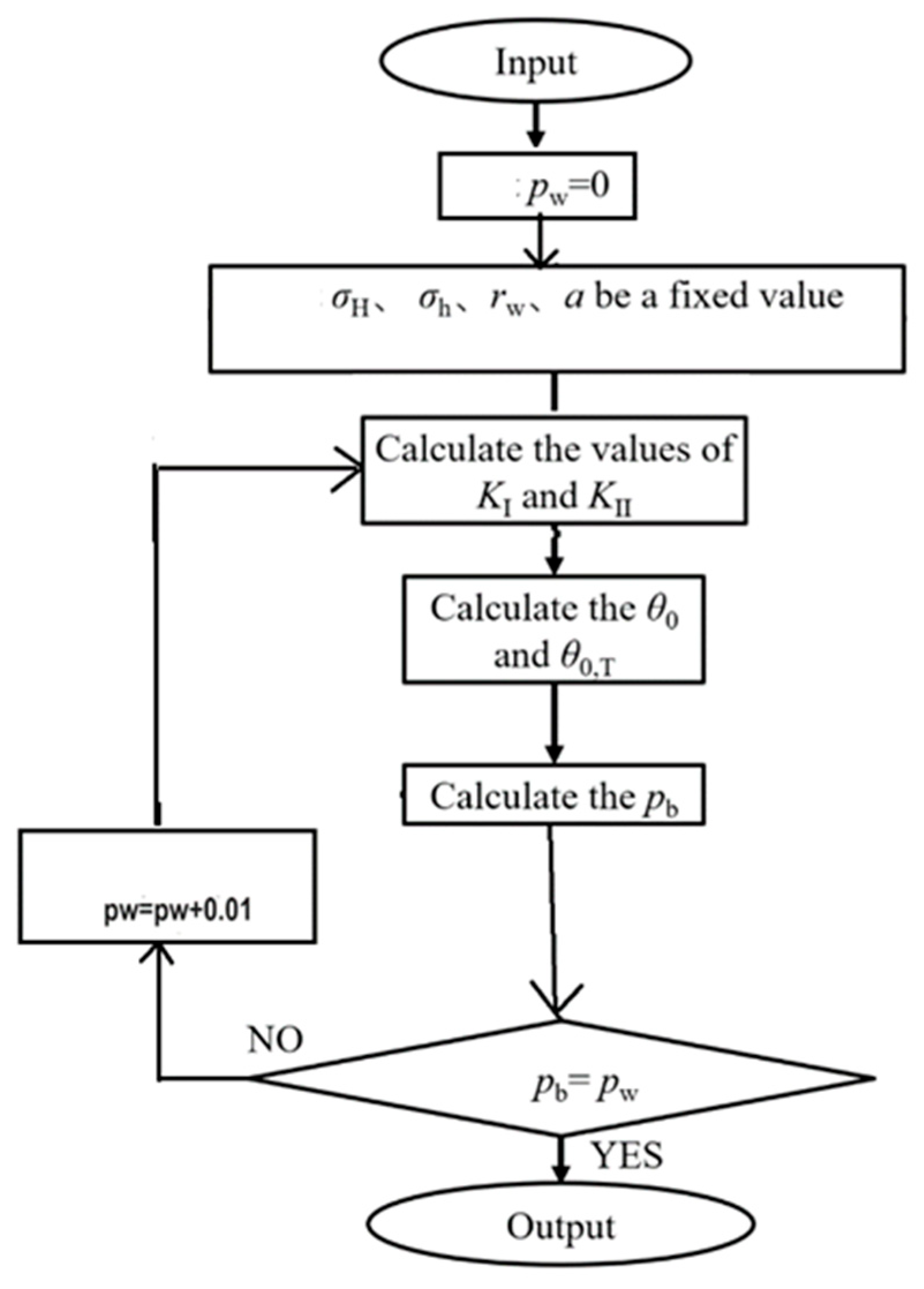
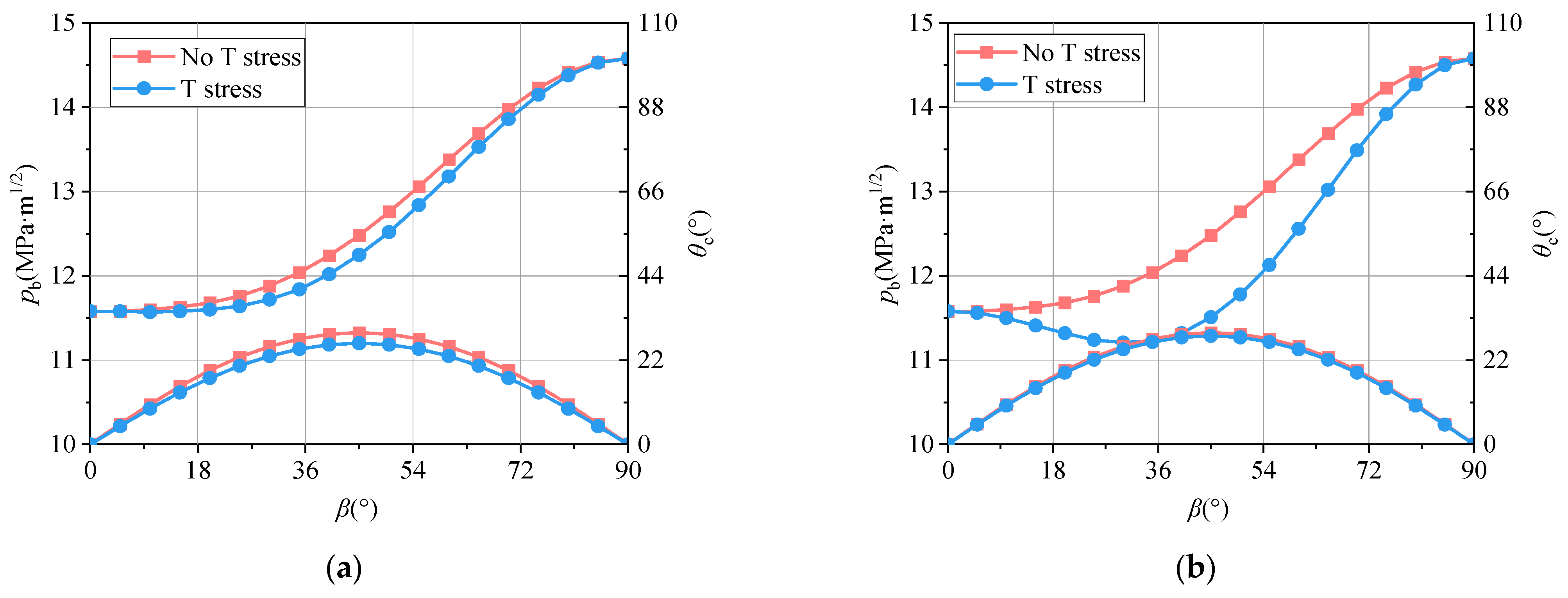
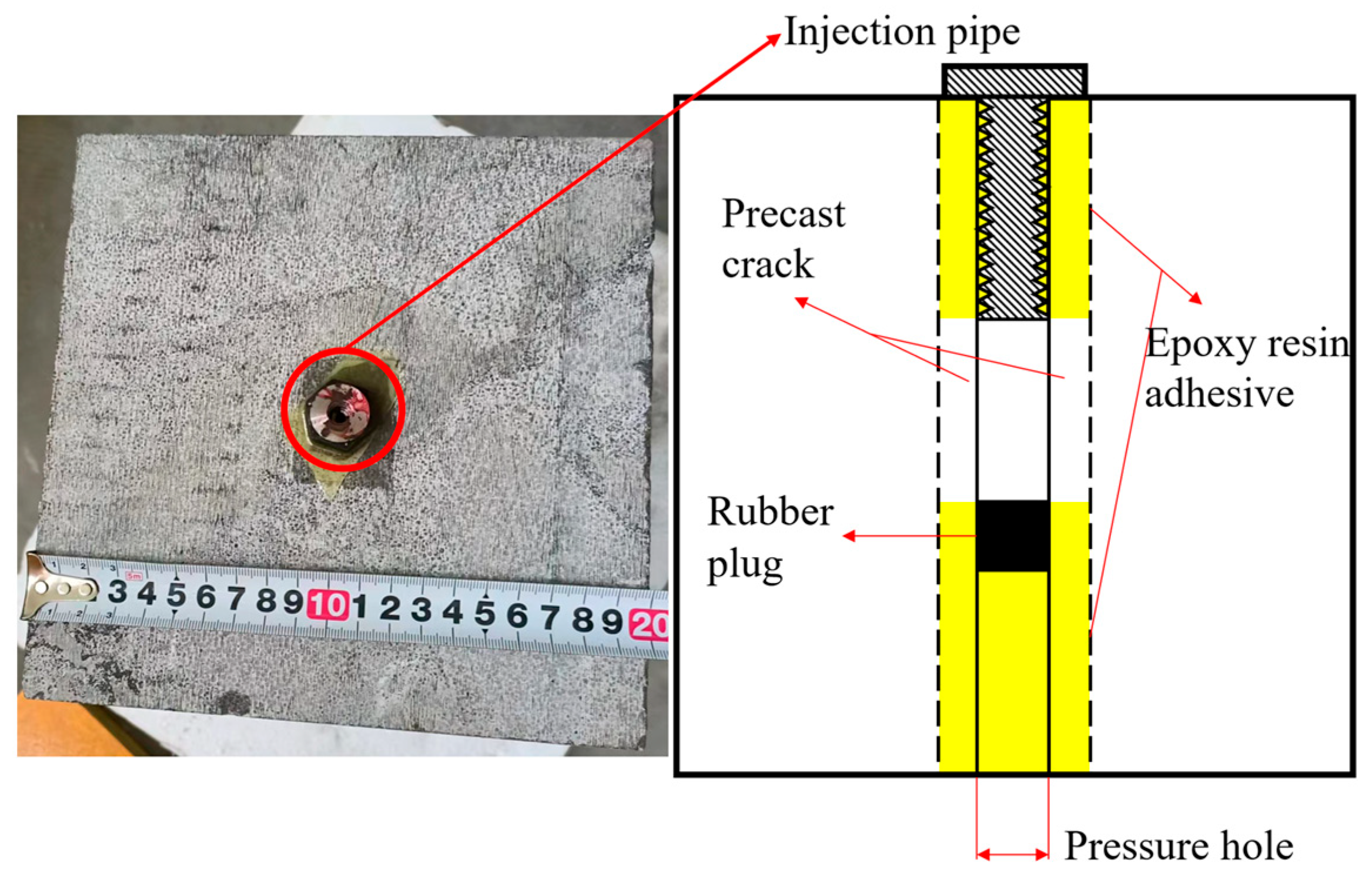


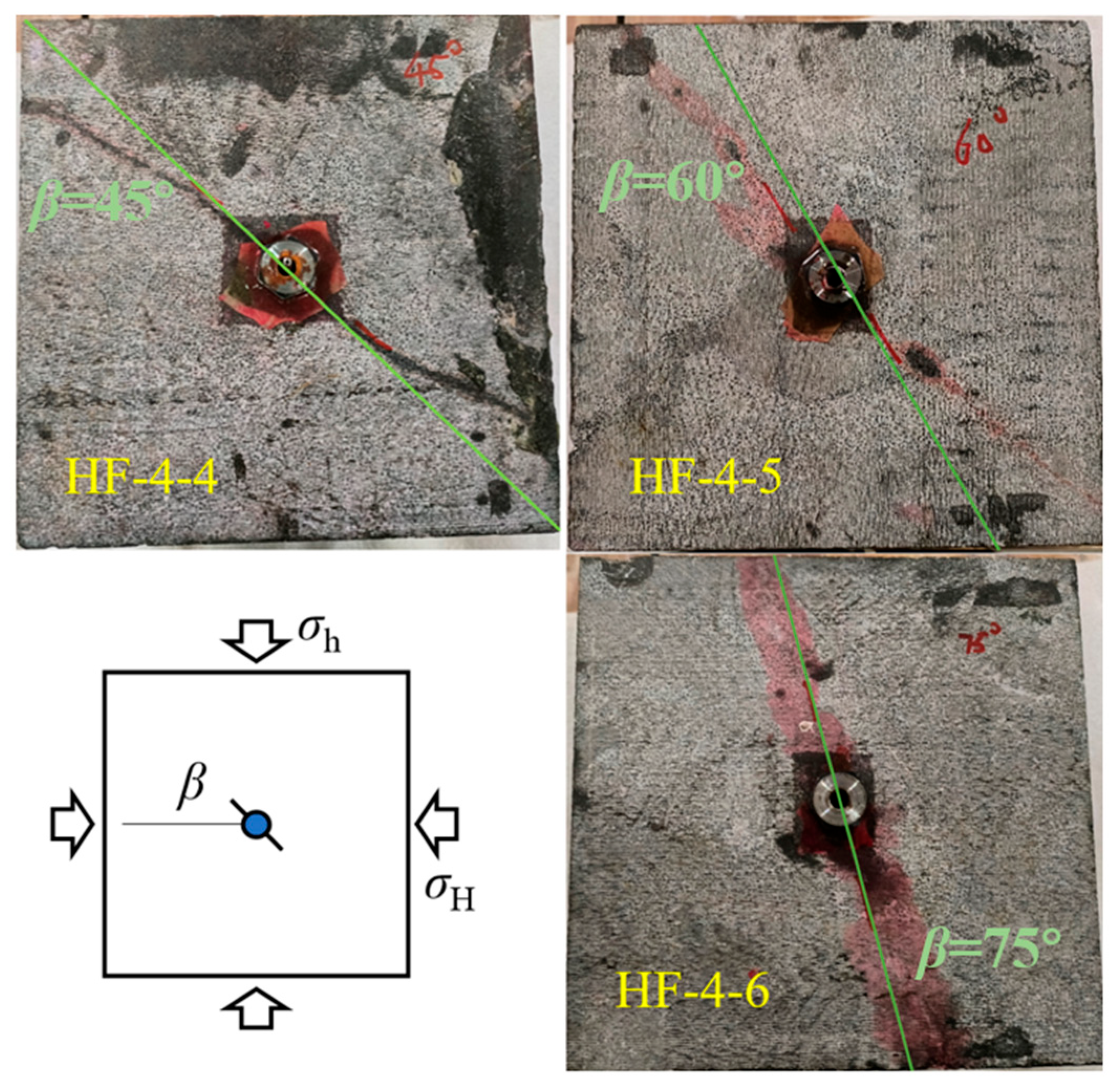
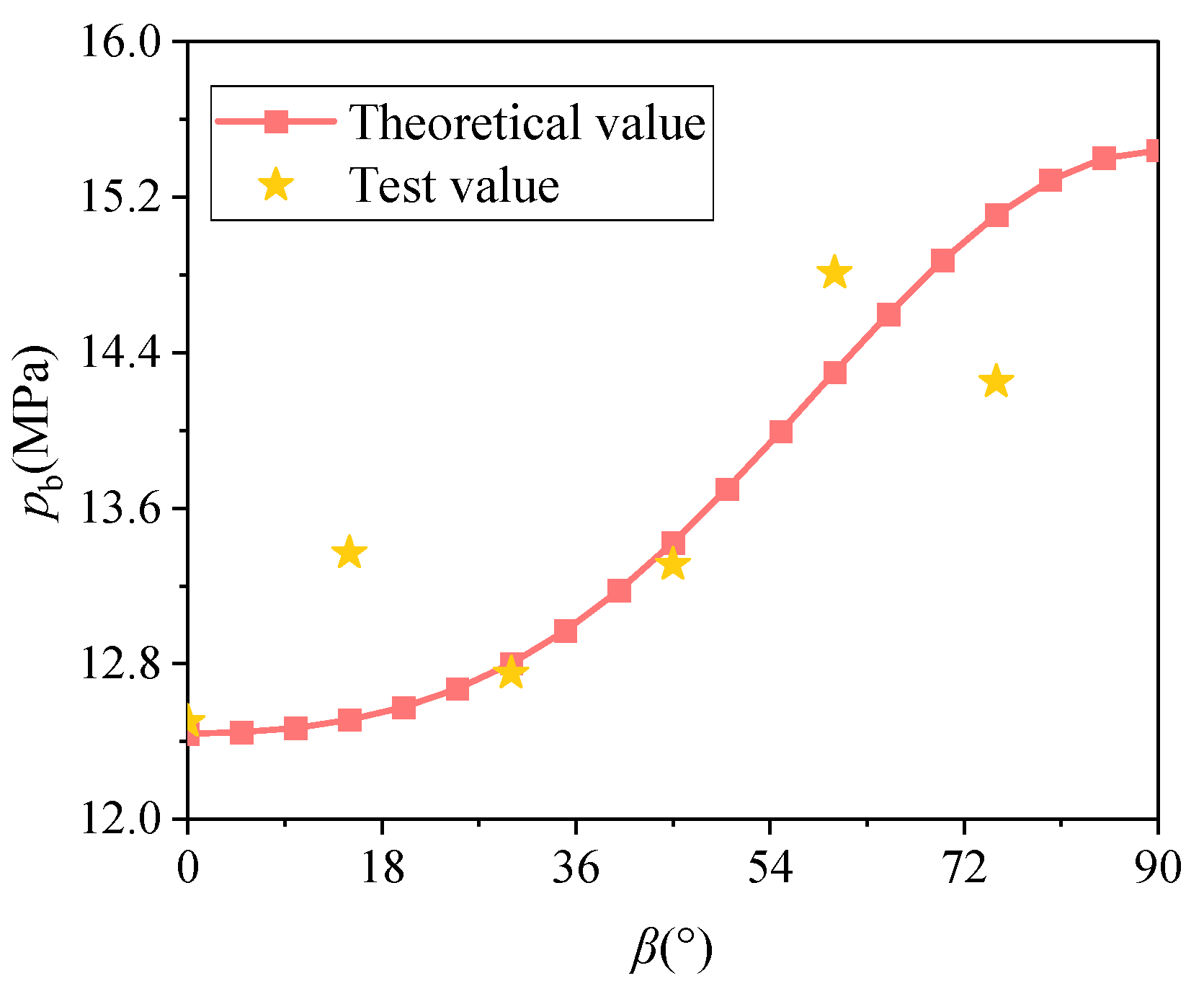
| Parameter | Value |
|---|---|
| Cohesive force c | 24.44 MPa |
| Internal friction angle of rock φ | 40.77° |
| Compressive strength σp | 155.81~210 MPa |
| Tensile strength σt | 7.5~13.5 MPa |
| Modulus of elasticity E | 82.3~92.5 GPa |
| Poisson’s ratio v | 0.17~0.3 |
| β (°) | KI (MPa·m1/2) | KII (MPa·m1/2) | T (MPa) |
|---|---|---|---|
| 0 | 0.5498 | 0 | −17.5319 |
| 5 | 0.5873 | 0.2192 | −19.0127 |
| 10 | 0.5106 | 0.4175 | −17.3881 |
| 15 | 0.4124 | 0.6038 | −15.6009 |
| 20 | 0.2858 | 0.7739 | −13.4206 |
| 28.7 | ≈0 | 0.9040 | −7.7515 |
| ID | σz (MPa) | σH (MPa) | σh (MPa) | Injection Rate (mL/min) | β (°) |
|---|---|---|---|---|---|
| HF-1 | 12 | 9 | 6 | 20 | 0 |
| HF-2 | 12 | 9 | 6 | 20 | 15 |
| HF-3 | 12 | 9 | 6 | 20 | 30 |
| HF-4 | 12 | 9 | 6 | 20 | 45 |
| HF-5 | 12 | 9 | 6 | 20 | 60 |
| HF-6 | 12 | 9 | 6 | 20 | 75 |
| HF-7 | 12 | 9 | 6 | 20 | 90 |
Disclaimer/Publisher’s Note: The statements, opinions and data contained in all publications are solely those of the individual author(s) and contributor(s) and not of MDPI and/or the editor(s). MDPI and/or the editor(s) disclaim responsibility for any injury to people or property resulting from any ideas, methods, instructions or products referred to in the content. |
© 2024 by the authors. Licensee MDPI, Basel, Switzerland. This article is an open access article distributed under the terms and conditions of the Creative Commons Attribution (CC BY) license (https://creativecommons.org/licenses/by/4.0/).
Share and Cite
Tang, X.; Wan, W.; Lu, Z.; Chen, W. Study on Composite Fracture Characteristics and Hydraulic Fracturing Behavior of Hard Rock. Appl. Sci. 2024, 14, 2585. https://doi.org/10.3390/app14062585
Tang X, Wan W, Lu Z, Chen W. Study on Composite Fracture Characteristics and Hydraulic Fracturing Behavior of Hard Rock. Applied Sciences. 2024; 14(6):2585. https://doi.org/10.3390/app14062585
Chicago/Turabian StyleTang, Xiaoyu, Wen Wan, Zhenxing Lu, and Wei Chen. 2024. "Study on Composite Fracture Characteristics and Hydraulic Fracturing Behavior of Hard Rock" Applied Sciences 14, no. 6: 2585. https://doi.org/10.3390/app14062585






